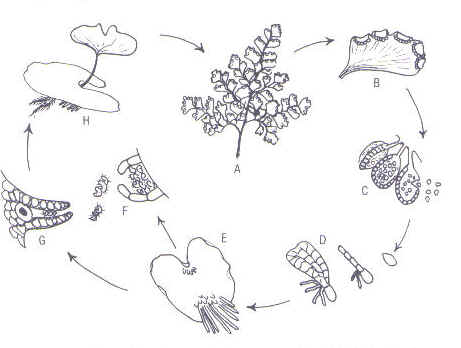|

Life cycle of a typical fern
In this illustration,
A represents the
mature fertile frond of an Adiantum species, Maidenhair
fern.
B
shows the fertile pinnule and the sori along the margin (edge of leaf).
There is a
flap of tissue known as an indusium covering the sporangia (where
spores are located). C, sporangia and spores, D,
first obvious step in the production of a new fern, this is the
gametophyte stage or prothallus. E, prothallus underside bearing
rhizoids that anchor the prothallus to soil. F, Antheridia (male)
releasing spermatozoides and G, the archegonia
(female) containing
the egg to be fertilized. H, a new Adiantum (sporophyte) attached
to the prothallus with a juvenile frond and developing root system.
The plant that we then see is known
as the sporophyte. Not all ferns will reproduce in the
above manner. Some
genera such as the Angiopteris and Lycopodium depend on another
important step to complete the germination process. This usually requires
the introduction
of a specific fungus, known as mychorrizae to invade the
gametophyte to help the sporophyte develop.
Pteridophyta
Ferns are considered vascular plants and are some of
the oldest living plants on earth.
Currently there are between 10,000 and
12,000 fern species in the world. The ferns,
generally known as
pteridophytes, also includes plants that are called the fern allies.
These
plants consists of the families of Psilotum, Iosetes, Lycopodium, Equisetum, and
Selaginella. The fern allies also include the rarely cultivated
Tmesipteris of Australia
and New Caledonia.
One of the most interesting of the fern allies is the
Lycopodium group. In the Carboniferous
the lycopods dominated the
landscape; they were giants among plants.
Ferns do not produce flowers, nor fruit nor
seeds. The inappropriate name of Artillery fern
and Asparagus ferns are
misnomers. Upon careful inspection of these plants they are not
ferns
because they produce flowers and seeds.
When observing a fern, the leafy section of the fern is
typically known as a frond. The
smaller segments that make up the entire
frond are called pinnae. And, an individual
section is known as the
pinnule. When observing ferns, people know
them to have spores. However, the spores are usually
not apparent because
they are microscopic. What you generally see is the sori. The sori
is the outside protection which encases the sporangia which houses the spores.
Sporangia
are usually, but not always confined to the underside of the
frond. The sori may look like
fruit dots, or squiggly lines, or even
straight lines. While these are not technical descriptions
for them, they
are never-the-less a necessary component in what a fern is. Many ferns are
identified by the type of sori they have. Sometimes
the sori are located along the margins of the pinnules, or they may follow the
veins on the pinnae, or simply may cover the entire underside of the frond. Dimorphic
fronds Many ferns are very clever in the
way they display their fertile fronds. While the majority
of them display
their sori underneath the frond, many have interesting adaptations. One
genus, Belvisia,
has sori along whip that resembles a rat's tail. Another fern Heterogonium
pinnatum has a highly contracted fertile frond.
And then on a couple of the Platycerium,
there are special spoon shaped lobes
bearing the sporangia. There are many ferns with
dimorphic fronds, for instance the Platycerium group is strongly dimorphic.
Some of the Tectarias too are dimorphic, as are members of the Aglaomorpha
group. Mother
Ferns Just a brief note about Mother
ferns. This does not include all of the ferns which are known
to produce
bulbils on their fronds. There is a much greater list.
Everyone seems to know
at least one mother fern by sight. However, this name applies to
a much broader
spectrum of ferns that produce bulbils, bulblets, babies, pups, etc.
|
